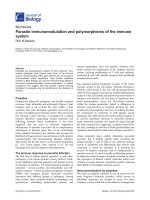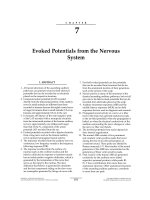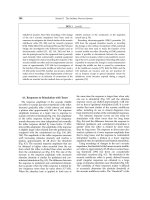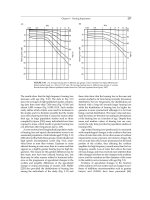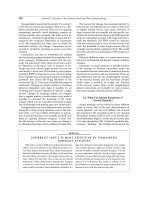Test bank for basic immunology functions and disorders of the immune system 4th edition by abbas
Bạn đang xem bản rút gọn của tài liệu. Xem và tải ngay bản đầy đủ của tài liệu tại đây (509.74 KB, 12 trang )
Link full download: />
Test Bank for Basic Immunology Functions and Disorders of the
Immune System 4th Edition by Abbas
Chapter 04: Antigen Recognition in the Adaptive Immune System
Test Bank
MULTIPLE CHOICE
1. Most T lymphocytes have a dual specificity for which one of the following
pairs of molecules?
2. A particular allelic form of a major histocompatibility complex (MHC)
molecule and a peptide bound to the MHC molecule
3. Both MHC class I and class II molecules
4. Both peptide and glycolipid antigens
5. Both soluble peptides and peptide-MHC complexes
6. MHC molecules and CD4 or CD8
ANS: A
Most T cells are specific for polymorphic residues of a self major histocompatibility
complex (MHC) molecule, which accounts for their MHC restriction, and for residues
of a peptide antigen displayed by the MHC molecule, which accounts for antigen
specificity. The receptor that recognizes peptide-MHC complexes is called the T cell
receptor (TCR). Mature ab T cells (the predominant type) express either CD4 or
CD8, but not both. As such, each ab T cell is restricted to bind either MHC class II or
class I molecules, but not both. Although a small subset of T cells may recognize
glycolipid antigens bound to class I MHC-like molecules called CD1, these T cells do
not also recognize peptide antigens. Unlike the B cell receptor (immunoglobulins),
the TCR can recognize only peptides displayed on MHC molecules, not soluble
peptides alone. T cells express CD4 or CD8 and do not recognize CD4 or CD8 on
other cells.
2.
3.
4.
5.
The T cell receptor (TCR) complex contains:
A highly variable antigen coreceptor
CD28
Three homologous CD3 chains, each covalently linked to the TCR ab
heterodimer
6. Invariable z chains noncovalently linked to the TCR ab heterodimer
7. Igb
ANS: D
The T cell receptor (TCR) complex contains a highly variable antigen receptor,
usually composed of a heterodimer of a and b chains, called the TCR, which is
responsible for antigen recognition, as well as invariant signaling proteins, CD3d,
CD3e, and CD3l, and the z protein. These signaling molecules are all noncovalently
associated with the TCR. Coreceptors for T cells include CD4 and CD8; these are
invariant proteins and are not part of the TCR complex itself. CD28 is involved in T
cell costimulation, but it is not a member of the TCR complex. Igb is a component of
the B lymphocyte antigen receptor complex.
3. A 4-year-old boy suffers from an immunodeficiency disease characterized by
impaired T cell activation. The disease is caused by genetic deficiency of a
membrane protein whose cytoplasmic tail is involved in intracellular
signaling in response to T cell receptor (TCR) recognition of antigen. Which
one of the following proteins does NOT fit this description?
4. TCRa
5. CD3g
6. z
7. CD4
8. CD3e
ANS: A
Although the T cell receptor (TCR) a and b chains are responsible for antigen
recognition, they are not directly involved in signaling. Rather, the ab heterodimer is
noncovalently associated with signaling molecules CD3g, CD3d, CD3e, and z, all of
which have ITAMs in their cytoplasmic tails. Although CD4 is not part of the TCR
complex, it does play a critical role in initiating signaling during TCR recognition of
antigen by binding Lck to its cytoplasmic tail and bringing this tyrosine kinase near
the ITAMs of CD3 and z.
4. A healthy 45-year-old child-care worker becomes infected with a virus and
develops a sore throat, cough, and fever. Infected cells in the bronchial
mucosa of this patient process virus-encoded proteins through an
intracellular pathway and display peptides derived from the protein on the
cell surface bound to class I MHC molecules. CD8+T cells migrate to the
mucosa and recognize these peptide-MHC complexes. Which of the following
components of the TCR actually bind to the viral peptide-MHC complex?
5. Hypermutated regions: 1 in the a chain, 2 in the b chain
6. Complementarity-determining regions: 3 in the a chain, 3 in the b chain
7. Hypervariable regions: 2 in the a chain, 2 in the b chain
8. Congenic regions: 1 in the a chain, 1 in the b chain
9. One peptide-binding groove formed by the a chain and the b2-microglobulin
chain
ANS: B
Each a and b chain of the T cell receptor (TCR) contains both a constant and a
variable domain. The variable domain contains short stretches of amino acids where
the variability between different TCRs is concentrated, and these form the
hypervariable or complementarity-determining regions (CDRs). Three CDRs in the a
chain are juxtaposed to three similar regions in the b chain to form the part of the
TCR that specifically recognizes peptide-MHC complexes. The variable regions of Ig
molecules may undergo hypermutation during humoral immune responses, but this
does not happen in TCRs. Congenic does not refer to a part of a protein, but rather to
an inbred strain of animal. Peptide-binding grooves are part of MHC molecules, not
TCRs.
5. The T cell receptor (TCR) complex differs from an immunoglobulin molecule
in which one of the following ways?
6. On average, a TCR binds antigen with much lower affinity than does an Ig
molecule.
7. The TCR can serve as a lymphocyte antigen receptor, but an Ig molecule
cannot.
8. Only the TCR can bind soluble antigen directly.
9. The TCRs expressed by one clone of T cells can undergo changes in constant
region structure after cellular activation, whereas Ig molecules expressed by
one clone of B cells do not.
10. The TCR polypeptide chains have short cytoplasmic tails and rely on
associated proteins for signaling functions, whereas membrane Ig receptors
are competent signaling molecules on their own.
ANS: A
TCRs bind antigen with much lower affinity than immunoglobulins (the dissociation
constant for the TCR is 10-5 to 10-7 versus 10-7 to 10-11 for secreted Ig). Both T
cell receptors (TCRs) and membrane Ig serve as lymphocyte antigen receptors on T
cells and B cells, respectively. TCRs do not bind soluble antigens, but rather cell
surface–associated peptide-MHC molecule complexes. Only immunoglobulins
undergo constant region changes, called heavy chain isotype switching. Both TCRs
and Ig have short cytoplasmic tails and rely on associated signaling molecules (CD3
and z for TCR, Iga and Igb for membrane Ig).
6. CD1-restricted T cells differ from other T cells restricted to class I or class II
MHC molecules in which one of the following ways?
7. CD-1 restricted T cells cannot rapidly secrete cytokines.
8. CD-1 restricted T cells recognize non-peptide antigens, such as lipids.
9. CD-1 restricted T cells bind both cell-associated and soluble antigens.
10. CD-1 restricted T cells express both CD4 and CD8 coreceptors.
11. CD-1 restricted T cells are actually natural killer (NK) cells.
ANS: B
A small population of T cells express T cell receptors that recognize lipids bound to
class I MHC–like molecules called CD1 molecules. These lipid antigen-specific T cells
include CD4+CD8+, or CD4-CD8- ab T cells. Many of these T cells also express
markers found on natural killer (NK) cells and are therefore called NK T cells,
although they are not actually NK cells. CD1-restricted T cells are still capable of
rapidly producing cytokines such as IL-4 and IFN-g, but their physiologic function is
unknown.
7. gd T cells may be important for recognition of common antigens at epithelial
boundaries between the host and the external environment. The gd T cells
differ from the ab T cells in which one of the following ways?
8. gd T cells recognize only nonprotein antigens.
9. gd T cells are not MHC-restricted and do not recognize MHC-associated
antigens.
10. The gd TCR complex contains CD3g or CD3d but not CD3e.
11. Most mature gd T cells express either CD4 or CD8 but not both.
12. gd T cells lack key biologic activities, including the ability to lyse target cells.
ANS: B
T cells expressing the gd TCR are a lineage distinct from the much more numerous
ab-expressing T lymphocytes. The gd T cells do not recognize MHC-associated
peptide antigens and are not MHC restricted. Some gd T cells recognize protein or
nonprotein antigens that do not require processing or particular types of antigenpresenting cells for their presentation. The gd heterodimer associates with the same
CD3 and z proteins as do ab receptors. Most gd cells do not express CD4 or CD8. The
gd cells are capable of several biologic activities, including secretion of cytokines
and lysis of target cells.
8. CD8 is a protein that functions as a coreceptor for a subset of T cells and plays
a significant role in all of the following EXCEPT:
9. Recognition of peptide antigen bound to class I MHC molecules
10. Maturation of MHC class I–restricted T cells
11. Infection of T cells by human immunodeficiency virus (HIV)
12. Signaling via Lck tyrosine kinase to initiate T cell activation
13. Strengthening the binding of T cells to antigen-presenting cells, albeit with
low affinity
ANS: C
CD4, but not CD8, serves as a receptor for the human immunodeficiency virus (HIV).
CD8 is a coreceptor that binds to class I MHC molecules. It is expressed on T cells
whose T cell receptors (TCRs) recognize complexes of peptide and class I MHC
molecules. CD8 plays a critical role in the maturation of class I MHC–restricted T
cells in the thymus because this process requires the maturing T cells to recognize
class I MHC on thymic antigen-presenting cells (APCs). Both CD8 and CD4 associate
with the Src family tyrosine kinase, called Lck, and thus they participate in the early
signal transduction events that occur after T cell recognition of peptide-MHC
complexes on APCs. The affinities of CD8 and CD4 for MHC molecules are very low,
but they are still thought to play some role in mediating adhesion between T cells
and APCs.
9. After 2 years of hard work, a graduate student finally succeeds in creating a
gene knockout mouse lacking CD4. The student is particularly careful to keep
this mouse line in a microbe-free animal facility because these mice are
expected to show:
10. No ability to produce IgM antibodies
11. Impaired ability to produce antibodies and activate macrophages
12. No ability to activate naive class I–restricted T cells
13. Complete absence of cytotoxic T lymphocyte (CTL) responses to viral
infections
14. Failure to produce neutrophils
ANS: B
Knockout mice lacking CD4 do not contain mature class II–restricted T cells because
the CD4 coreceptor plays an essential role in the maturation of T cells in the thymus.
Most CD4+ class II–restricted T cells are cytokine-producing helper cells that
function in host defense against intracellular microbes. These helper T cells are
critical for activating B cells to produce antibodies, and for activating macrophages
to efficiently kill phagocytosed microbes. Knockout mice lacking CD4 therefore do
not have any helper T cells. IgM antibody production is generally not dependent on
help from CD4+ T cells. Because CD8 is still expressed, naive class I–restricted T
cells are still present and able to respond to intracellular infections, although this
ability may be impaired by lack of T cell help. Neutrophil production by the bone
marrow should be relatively normal.
10. Which of the following is NOT a property shared by both CD4 and CD8?
11. Binds to nonpolymorphic regions of MHC molecules
12. Cytoplasmic tail associates with the Src family kinase Lck
13. Is a member of the Ig superfamily
14. Functions as a coreceptor for ab TCRs
15. Is expressed on the majority of mature blood T cells
ANS: E
CD4 is expressed on the majority (~65%) of mature blood T cells, whereas CD8 is
expressed on a minority (~35%). Both CD4 and CD8 are transmembrane
glycoprotein members of the Ig superfamily, both serve as MHC-binding coreceptors
for the T cell receptor, and both participate in early signal transduction events via
cytoplasmic tail binding of the Src family tyrosine kinase Lck.
11. A 15-year-old girl develops malaise, headache, and low-grade fever, followed
by pharyngitis and cervical lymph node enlargement as a result of infectious
mononucleosis caused by Epstein-Barr virus (EBV). Her acute symptoms
resolve within 2 weeks, and the fatigue improves within 3 months. All of the
following are required for CD8+cytotoxic T lymphocyte (CTL) recognition and
killing of EBV-infected cells EXCEPT:
12. b2-Microglobulin
13. HLA-A, -B or -C
14. CD28
15. LFA-1 (leukocyte function-associated antigen-1)
16. TAP (transporter associated with antigen processing)
ANS: C
CD28 is not involved in antigen recognition by T cells, but rather, in costimulation.
Cell-mediated immunity against intracellular organisms, such as viruses, is largely
mediated by class I–restricted T cells, such as cytotoxic T lymphocytes (CTLs). The
class I MHC molecules are HLA-A, HLA-B, and HLA-C. CTLs recognize complexes of
viral peptides with class I MHC molecules. b2-Microglobulin is the nonpolymorphic,
noncovalently associated polypeptide chain of MHC class I molecules. TAP is a
critical protein involved in the processing and presentation of antigen by class I
MHC. LFA-1 is an important integrin mediating adhesion of the CD8+ T cells to
virus-infected target cells.
12. A 15-year-old girl develops malaise, headache, and low-grade fever, followed
by pharyngitis and cervical lymph node enlargement as a result of infectious
mononucleosis caused by Epstein-Barr virus (EBV). Her acute symptoms
resolve within 2 weeks, and the fatigue improves within 3 months. Following
the primary infection described in this patient, the patient’s subsequent
exposure to Epstein-Barr virus (EBV) will trigger clonal expansion of EBVspecific T cells expressing which one of the following surface molecules?
13. CD62Lhigh
14. CD44low
15. CD45RAhigh
16. CD45ROhigh
17. CD21high
ANS: D
After primary infection, subsequent exposure to Epstein-Barr virus (EBV) (i.e.,
secondary infection) will trigger clonal expansion of EBV-specific memory T cells.
Memory T cells express CD45RO. CD45RA is expressed on naive human T cells.
CD62L, or L-selectin, is a peripheral lymph node homing receptor that is expressed
at high levels on naive T lymphocytes but not on activated or memory T
lymphocytes. CD44 is an adhesion molecule that is expressed at low levels on naive
T lymphocytes and at high levels on activated and memory T lymphocytes. CD21 is
actually the EBV receptor, but it is expressed on B cells (and follicular dendritic
cells). It normally functions as a coreceptor to deliver activating signals in B cells.
13. Both CD28 and CTLA-4 are receptors on T cells that are critical for regulating
T cell activation. In which one of the following ways does CD28 differ from
CTLA-4?
14. Only CD28 binds the costimulatory ligands B7-1 and B7-2 expressed on
professional antigen-presenting cells.
15. CD28 counteracts positive, pro-proliferative T cell signals delivered by CTLA4.
16. CD28 is constitutively expressed on naive T cells, whereas CTLA-4 is
expressed on activated T cells.
17. CD28 binds its ligand with 10-fold greater affinity than does CTLA-4.
18. CD28 is important for delivering “signal 1” for T cell activation, whereas
CTLA-4 is important for delivering “signal 2.”
ANS: C
CD28 is constitutively expressed on more than 90% of CD4+ T cells and 50% of
CD8+ T cells, whereas CTLA-4 is expressed only on activated T cells. Both B7-1 and
B7-2, expressed on professional antigen-presenting cells (APCs), bind to both CD28
and CTLA-4 receptors on T cells. Binding of B7 molecules on APCs to CD28 delivers
“positive” signals to the T cells that stimulate production of growth factors, promote
T cell proliferation and differentiation, and induce expression of anti-apoptotic
proteins. CTLA-4, however, functions to inhibit T cell activation by counteracting
signals delivered by CD28. CTLA-4 also binds B7-1 with 10-fold greater affinity than
CD28 binds B7-1; this difference may play an important role in the temporal
sequence of T cell activation.
14. LFA-1 is an integrin that promotes T cell activation by which one of the
following mechanisms?
15. Binds to the a3 domain of class I MHC molecules, mediating high avidity
between T cells and antigen-presenting cells (APCs)
16. Binds to B7-1 or B7-2 on the surface of APCs, mediating “signal 2”
17. Binds to GlyCAM-1 on high endothelial venules of lymph nodes, mediating
rolling of T cells on endothelium
18. Binds to ICAM-1 on the surface of a variety of cells, mediating firm adhesion
between T cells and APCs or endothelial cells
19. Binds to VCAM-1 on the surface of cytokine-activated endothelial cells,
mediating homing of T cells to peripheral sites of inflammation
ANS: D
LFA-1 is an integrin expressed on the surface of leukocytes, which binds ICAM-1 to
mediate specific, firm adhesion between T cells and antigen-presenting cells, as well
as leukocytes and endothelial cells. As such, it plays an important role in the
activation of T lymphocytes and in their migration to sites of infection and
inflammation. In contrast, CD8 binds the a3 domain of class I MHC molecules, CD28
and CTLA-4 bind B7 proteins, L-selectin is the receptor for GlyCAM-1, and VLA-4 is
the receptor for VCAM-1.
15. Selectins differ from integrins in which one of the following ways?
16. Selectins are expressed only on endothelial cells and integrins are expressed
only on leukocytes.
17. Selectins are important mediators of leukocyte adhesion to endothelium, but
integrins are not.
18. Selectins bind carbohydrate ligands, but integrins do not.
19. Selectins mediate rolling of leukocytes on endothelium, but integrins do not.
20. Selectins are a family of homologous molecules, but integrins are not.
ANS: C
Selectins specifically bind carbohydrate groups on cell surface glycoproteins,
whereas integrins do not bind carbohydrate groups on Ig superfamily molecules. Lselectin and several integrins are both expressed on some lymphocytes. Both
selectins and integrins are important mediators of leukocyte adhesion to
endothelium. Both selectins and integrins (especially VLA-4) can mediate rolling
interactions; selectins are more specialized in this regard. There are three members
of the selectin family (E-, P-, and L-) and more than 30 different members of the
integrin family.
16. A 2-year-old boy suffers from recurrent bacterial infection of his ears, sinuses,
lungs, and skin; laboratory studies indicate absence of sialylated Lewis X on
his leukocytes. He is diagnosed with leukocyte adhesion deficiency type 2
(LAD-2). Which type of adhesive interaction required for leukocyte migration
is defective in this boy?
17. E-selectin ligand binding to E-selectin
18. CD4 binding to class II MHC
19. VLA-4 binding to VCAM-1
20. Ig Fc receptor binding to Ig-coated cells
21. LFA-1 binding to ICAM-1
ANS: A
Leukocyte adhesion deficiency type 2 (LAD-2) is a rare genetic disorder
characterized by severely impaired neutrophil rolling and adhesion to activated
endothelium. The cause is a defect in the synthesis of sialylated Lewis X, the
carbohydrate ligand on neutrophils and other leukocytes that is required for
binding to E-selectin and P-selectin on cytokine-activated endothelium. In a
clinically similar disorder called LAD-1, there is absent or deficient expression of the
CD11CD18 family of integrins (of which LFA-1 is a member). Adhesion interactions
mediated by CD4, Fc receptor, and VLA-4 are normal in patients with LAD-2.
17. CD44 expressed on the surface of T cells is critical for the binding of activated
T cells to endothelium at sites of inflammation, and for the retention of T cells
in extravascular tissues at sites of infection. CD44 does this by binding to
which one of the following molecules?
18. VCAM-1
19. Hyaluronate
20. ICAM-1
21. Fibronectin
22. E-selectin
ANS: B
CD44 is a glycoprotein expressed on a variety of cells, particularly on recently
activated and memory T cells. CD44 binds to hyaluronate, which allows for the
retention of T cells in extravascular tissues at sites of infection and for the binding of
activated and memory T cells to endothelium at sites of inflammation.
18. Neonates, elderly persons, and otherwise immunocompromised patients are
particularly susceptible to infections with Listeria monocytogenes. These
patients typically have fever and chills, often progressing to hypotension and
septic shock. In healthy individuals, however, such intracellular microbes are
usually effectively phagocytosed and killed by macrophages, which become
activated via:
19. CD40L-CD40 interactions between activated T helper cells and macrophages
20. CD28-B7 interactions between activated T cells and macrophages
21. Fas ligand–Fas interactions between activated cytotoxic T lymphocytes and
macrophages
22. TCR-MHC class II interactions between activated T helper cells and
macrophages
23. LFA-1–ICAM-1 interactions between activated T cells and macrophages
ANS: A
Activated CD4+ T cells express CD40 ligand (CD40L), which binds to CD40 on B
lymphocytes, macrophages, dendritic cells, and endothelial cells thereby activating
these cells. Only activated macrophages can effectively phagocytose and kill
intracellular microbes such as Listeria. CD28-B7 and TCR-MHC class II interactions
provide signals 2 and 1, respectively, in the activation of T cells by antigenpresenting cells (not the activation of macrophages by T cells). Engagement of Fas
by Fas ligand (FasL) on T cells results in apoptosis and provides one of the
mechanisms by which CTLs kill their targets. LFA-1–ICAM-1 mediates cell adhesion
interactions important in T cell activation and homing.
19. The strength of integrin-dependent binding of T cells to antigen-presenting
cells (APCs) may be rapidly increased by which one of the following
mechanisms?
20. Integrin clustering and increased integrin affinity are induced by chemokines
and antigen recognition.
21. Integrins stored in cytoplasmic organelles are mobilized to the T cell surface
in response to TCR-mediated signals.
22. Integrin gene transcription is enhanced by chemokine-generated signals.
23. The affinity of integrin ligands on APCs is increased in response to
chemokines.
24. Integrin ligands stored in cytoplasmic granules in the APCs are mobilized to
the cell surface in response to CD40-CD40 ligand interaction.
ANS: A
T cell integrin affinity is enhanced by “inside-out signaling” in response to antigen
binding to the T cell receptor (TCR) and chemokine binding to chemokine receptors.
In addition, antigen and chemokines can induce clustering of integrins in the region
of the T cell membrane in contact with the antigen-presenting cell (APC). These
changes cause stronger T cell binding to APCs displaying the peptide-MHC complex
that the T cell recognizes, thus ensuring prolonged T cell/APC contact and T cell
activation. Integrins are not stored in cytoplasmic granules, and transcriptional
activity cannot account for rapid changes in integrin-mediated binding. Integrin
ligands (such as ICAM-1) do not undergo changes in affinity, nor are they stored in
cytoplasmic granules.
